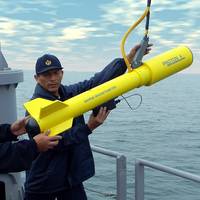New Technology for Subsea Pipe and Cable Tracking

Utility companies have been laying pipes and cables across the ocean floor for more than a century. Prior to the introduction of GPS, marking their location was difficult, and position information was often erroneous. It is extremely important to know where existing lines lie before undertaking dredging operations or when new pipes and cables are laid down. Regulations require they be buried from several feet to several meters under the bottom to prevent snagging by anchors and…
Marine Industry Employs Boat Towed Detectors

Many marine service companies are acquiring boat-towed metal detectors and magnetometers to assist in salvage operations and geophysical surveys. These devices can locate a variety of targets including sunken vessels, ship anchors and propellers, pipelines, cables and metal debris which must be removed from an area before dredging. The two primary pieces of equipment used in these operations are a magnetometer and the pulse induction (PI) metal detector. Magnetometers are super sensitive instruments that can detect iron and steel objects at hundreds of feet away.
Boat-towed Detectors Assist Researchers and Salvors

A number of archaeological groups and marine service companies are acquiring boat-towed metal detectors to assist in locating shipwrecks and to perform geophysical surveys. These devices can locate a variety of targets including the piles of magnetic ballast stones found on many old wrecks, gold and silver bars, cannons, anchors, pipelines, cables, and various metal debris which must be removed from an area before dredging. The two primary pieces of equipment used in these operations are a magnetometer and pulse induction (PI) metal detectors.
The Search Is On For WWII Sub Detection Networks
Prior to the outbreak of WWII the Japanese began construction of several different types of midget submarines. Recognizing the strategic importance of such a weapon for combat use, Japan built hundreds of these "mini subs" ranging in size from just under 80 ft. to over 100 ft. Designed to carry a crew of 2 to 3 sailors and armed with two torpedoes, these small subs were originally intended to be transported on ships and deployed in the path of an enemy fleet. However, very quickly the Japanese saw the advantages of using the mini subs for special operations inside enemy harbors where conventional submarines could not go. To enhance their stealth capability, the midget subs were modified to ride atop full size subs and be deployed at sea near the target location.





